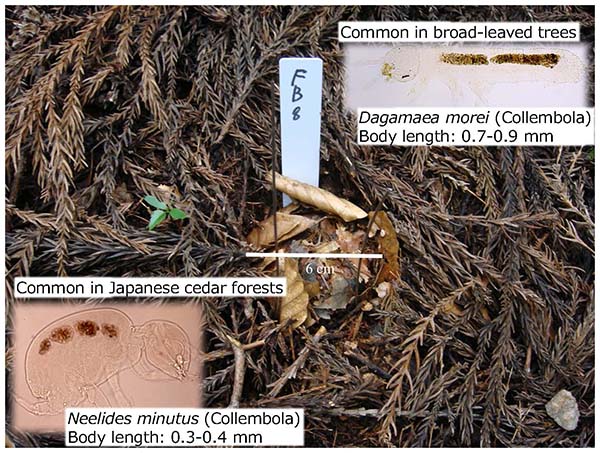Home > Research > Research Results > Research Results 2017 > Differences in soil fauna between coniferous plantations and deciduous forests are not only due to soil quality differences
Update:August 1, 2017
Main content starts here.
Differences in soil fauna between coniferous plantations and deciduous forests are not only due to soil quality differences
| Article title |
Assessment of the effects of soil and the site environment on collembolan community structure in deciduous forest and coniferous plantations using soil monolith transfer |
||
|---|---|---|---|
| Author (affiliation) |
Motohiro Hasegawa (a), Kimiko Okabe (b) (a) Shikoku Research Center, FFPRI, Kochi, Japan. (b) Center for Biodiversity, FFPRI, Tsukuba, Ibaraki, Japan. |
||
| Publication Journal |
European Journal of Soil Biology, 81:11-18, July-August 2017, DOI: 10.1016/j.ejsobi.2017.05.008( External link ) |
||
| Content introduction |
To conserve forest biodiversity, environmental conditions important to the living organisms of each forest need to be determined in detail. In this study, we examined deciduous forest areas that had been replaced by coniferous plantations to investigate what environmental conditions were important to the soil fauna in each forest type. Types and numbers (community structure) of Collembola (length: 0.3–2mm), a major group of soil fauna, are known to differ between coniferous plantations and deciduous forests. However, it is unknown whether this is due to soil quality differences or other factors (forest micro-climate, understory vegetation, etc.). We cut cylindrical cores of soil (base area: 25cm2, depth: 5cm) from a coniferous plantation and a deciduous forest and swapped them, with the Collembola contained therein (photograph) to investigate how important soil quality was to these organisms. If soil quality was important, we hypothesized that the original collembolan communities (i.e., transferred communities) would be maintained despite the soil being swapped. However, the results of the experiment showed that the swapped collembolan communities quickly changed, becoming similar to collembolan communities present in the original (“receiving”) soil. Accordingly, it appears that factors other than soil quality (forest micro-climate, understory vegetation, etc.) are responsible for differences in collembolan communities noted between different forest types. By clarifying these facts, factors related to maintaining living organisms present in each forest type can be determined. Such information can be useful when considering guidelines for managing the biodiversity of artificial forests.
|
||
Copyright © Forest Research and Management Organization. All rights reserved.

